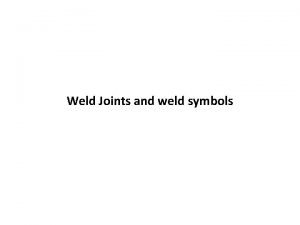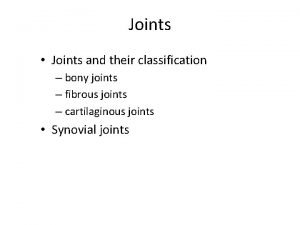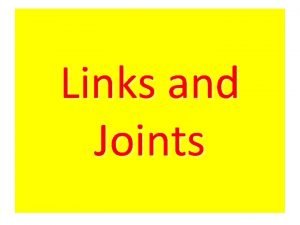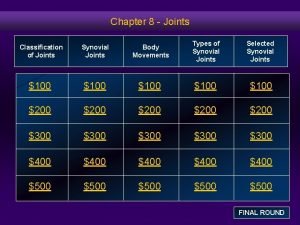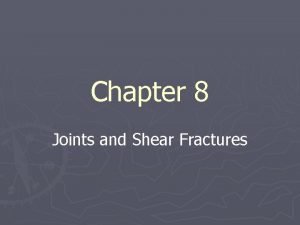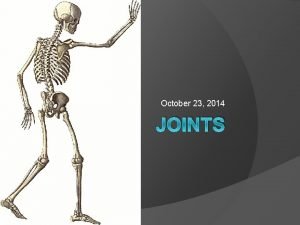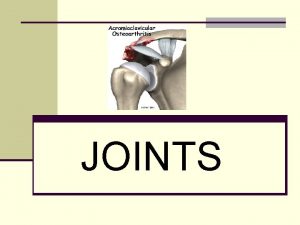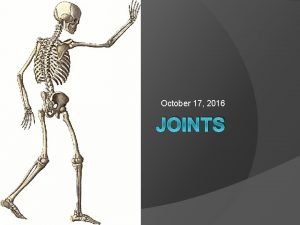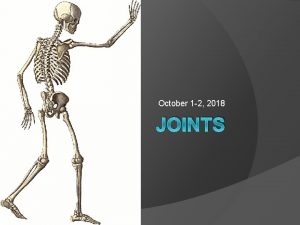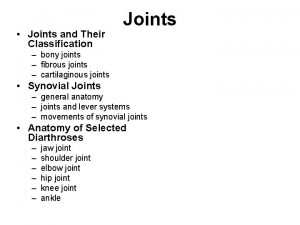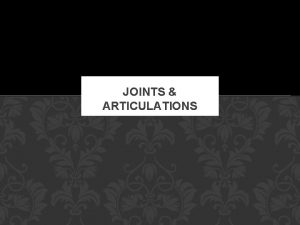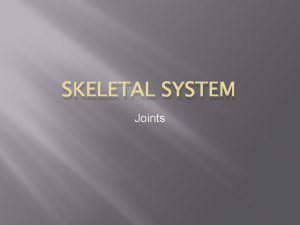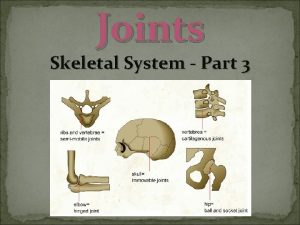THE SKELETAL JOINTS JOINTS Joints are where two
















- Slides: 16

THE SKELETAL JOINTS

JOINTS • Joints are where two or more bones articulate (move). • Joints are classified according to how much movement they allow. 1. Suture – these are fixed or immovable joints such as the cranium, sacrum and the coccyx. 2. Cartilaginous – these are slightly movable joints such as the vertebrae. 3. Synovial – these are freely movable joints such as the shoulder and hip.

Fibrous Joints • Bones are united by dense connective tissue consisting of collagen fibers which run between bones. • There is no joint cavity. • ONLY found in the skull.

Cartilaginous Joints • Joints where the articular surfaces of the bones forming the joints are attached to each other by cartilage and ligaments. • Allows only a limited degree of movement. • Examples: – cartilage between vertebrae, – between the pubic bones


Synovial joints There are 6 types of synovial joint. 1. Ball & socket – hip and shoulder. 2. Hinge – knee, elbow and ankle. 3. Pivot – radius/ulna, atlas/axis (neck). 4. Saddle – thumb. 5. Condyloid – wrist. 6. Gliding – between vertebrae in spine.

Ball & Socket joints • The hip joint • The head of the femur fits into a deep fossa called the acetabulum on the pelvic bone. • This deep cavity gives the hip joint stability. • The presence of strong ligaments add to the stability making it difficult to dislocate the hip.

Ball & Socket joints continued… • The shoulder joint • The head of the humerus fits into a shallow cavity on the scapula called the glenoid fossa. • The shoulder is the most mobile joint in the body but is also fairly unstable because of the shallow cavity. • Stability is improved by ligaments and muscles.

Hinge Joints • The knee joint • In the knee joint the femur articulates with the tibia. • The patella (knee cap) helps to give a better angle of pull. • The fibula is not part of the knee joint and so the tibia is the weight bearing bone.

• The ankle joint • In the ankle, the talus articulates with the tibia and fibula. • Ligaments provide stability to the joint. • The elbow joint • In the elbow the humerus articulates with the radius and the ulna. • Movement can only occur in one plane. Hinge Joints Continued…

The Pivot Joint • The radius/ulna • In this joint the radius and ulna articulate within the elbow joint. • This joint allows the elbow some twisting movement. • Atlas/axis • In this joint the atlas and axis bones articulate to allow a rotation movement as in shaking your head.

Condyloid • The wrist • Bones are oval in shape with one concave and the other convex. • Move from side to side and back and forth, but NO rotation. • In this joint the radius and ulna bones articulate with 3 of the carpal bones.

Plane Joint (Gliding joint) • Spine, carpals and tarsals • Bone surfaces are flat and only short, gliding movements are allowed.

Saddle Joint • This type of joint occurs when the touching surfaces of two bones have both concave and convex regions with the shapes of the two bones complementing one other and allowing a wide range of movement. • The only saddle joint in the body is the thumb.

Synovial Joint Anatomy • • Ligaments – connect bone to bone Tendons – connect muscle to bone Cartilage – cushion between bones Synovial Fluid – lubrication/oil to reduce friction between bones • Joint Cavity – space full of synovial fluid

Knee Joint Articular/Hyaline Cartilage Tendon
 Antigentest åre
Antigentest åre Stich weld symbol
Stich weld symbol Hình ảnh bộ gõ cơ thể búng tay
Hình ảnh bộ gõ cơ thể búng tay Bổ thể
Bổ thể Tỉ lệ cơ thể trẻ em
Tỉ lệ cơ thể trẻ em Gấu đi như thế nào
Gấu đi như thế nào Tư thế worm breton
Tư thế worm breton Chúa yêu trần thế alleluia
Chúa yêu trần thế alleluia Môn thể thao bắt đầu bằng từ đua
Môn thể thao bắt đầu bằng từ đua Thế nào là hệ số cao nhất
Thế nào là hệ số cao nhất Các châu lục và đại dương trên thế giới
Các châu lục và đại dương trên thế giới Công thức tính độ biến thiên đông lượng
Công thức tính độ biến thiên đông lượng Trời xanh đây là của chúng ta thể thơ
Trời xanh đây là của chúng ta thể thơ Mật thư anh em như thể tay chân
Mật thư anh em như thể tay chân Phép trừ bù
Phép trừ bù độ dài liên kết
độ dài liên kết

